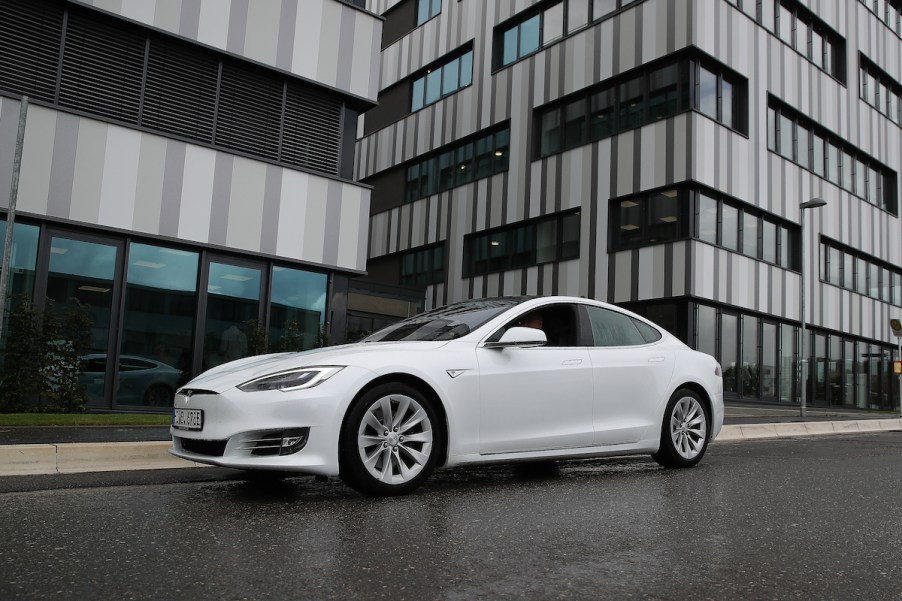
How Does Using AWD Affect an EV’s Driving Range?
Driving range remains one of the top considerations for prospective EV buyers. But many people, especially those new to electric vehicles, fail to consider all of the features, from heated seats to rear-seat infotainment systems, that automakers pack into new cars. EV driving range isn’t just a matter of whether a vehicle has a dual-motor system or a certain-sized battery pack. All of the extras also take a toll on the battery life.
If you’re considering an EV with all-wheel drive, you might wonder how much that feature affects battery life. After all, if you spend a week in the mountains with the AWD engaged, you don’t want to find yourself stranded.
How do EVs work with AWD?

Not that familiar with the mechanics of AWD? If all you know is that your drive feels more stable over rough terrain when using all-wheel drive, you might wonder how exactly it works with an EV. Well, first, a bit about how AWD works. There are two types: part-time and full-time. Typically, a vehicle with part-time AWD operates in either front-wheel or rear-wheel drive until the vehicle begins to slip or needs to speed up. Then AWD kicks in automatically by sending some power and torque to the rear wheels as needed.
In a full-time AWD system, the vehicle rides on all four wheels all the time. Doing so provides much greater traction. However, compared to a part-time AWD system, full-time AWD substantially reduces the fuel economy of gas-powered vehicles. Part-time AWD systems aren’t much better in terms of fuel efficiency. Though driving on two wheels part of the time reduces the amount of gas used, the automotive design allowing it to do so increases the car’s weight. And heavier cars use more fuel.
AWD systems are usually accompanied by ratios, such as 60/40 or 50/50. When AWD is activated, the first part of the ratio indicates how much power and torque can be sent to the vehicle’s front wheels, and the second part shows how much can be pushed to the rear wheels. Some vehicles have a lock feature, which, when enabled, sends 50% of the power and torque to the front and rear wheels, respectively.
AWD systems typically increase a gas-powered vehicle’s purchase price and fuel costs. But does the same hold true for EVs?
How does AWD affect an EV’s driving range?
Consumers already pay a premium for electric cars, though government tax credits help. But if you’re wondering whether AWD reduces an EV’s driving range, the answer is yes.
Consider some of the best-known EVs. If you look at the Volkswagen ID.4, its driving range with RWD is 280 miles. That drops to 251 miles with AWD. The Toyota bZ4X gets 252 miles on a full charge with FWD but only 222 miles with AWD. The Ford Mustang Mach-E’s RWD range is 230 miles, while its AWD range is 211 miles. And the Hyundai Ioniq 5 sees its range drop 47 miles — from 303 miles with RWD to 256 miles with AWD, according to Electric Vehicle Database.
Those are some steep drops. And they don’t fully account for other loads on the battery. If you’re charging your phone and using navigation, passengers are watching a show on an infotainment screen in the back, and the heat is on, those range numbers will likely drop even further.
What exactly accounts for the drop in range?
Now, those extras don’t account for substantial decreases in driving range. AWD requires specific mechanical equipment to turn all four wheels. That equipment is heavy. Again, the heavier the vehicle, the lower the fuel economy. You need more power to propel a heavier object, so AWD consumes more battery juice than FWD or RWD.
Also, remember that traversing rough terrain requires more power. The more traction your EV loses, the more power the AWD exerts to compensate. So if you’re driving on extremely slippery surfaces or in inclement weather, your EV’s AWD will tax the battery more than if you simply took a mile-long dirt-road detour between highway stretches.
Additionally, you’ll want to consider your hauling and towing needs. The more weight you need your engine to pull, the quicker your battery will drain. Before you tow your camper across the county with an AWD EV, you’ll need to ensure you’ve worked out charging solutions in advance.


